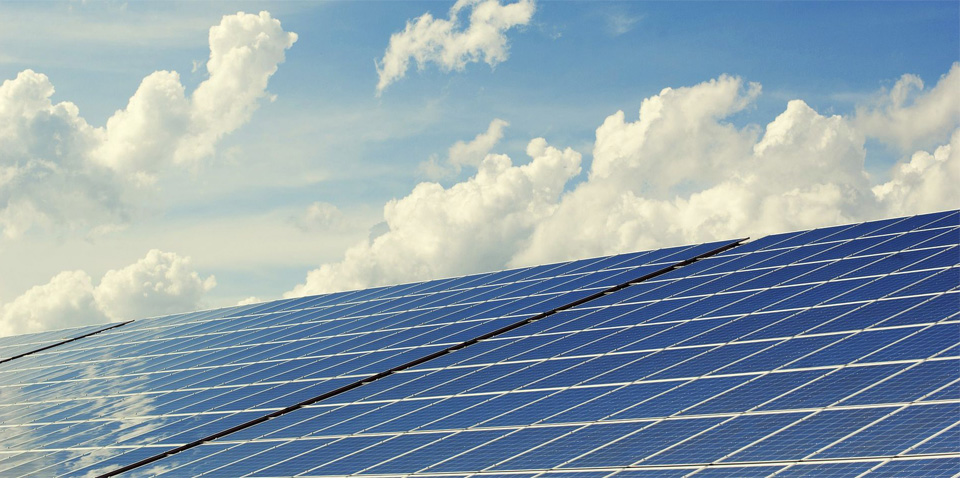Want to be in the loop?
subscribe to
our notification
Business News
SOCIAL AND ECONOMIC SITUATION IN 2017
1. Gross domestic product (GDP) growth
GDP in 2017 achieved an estimated growth of 6.81% compared with the same period last year, of which it increased by 5.15% in the first quarter; 6.28% in the second quarter; 7.46% in the third quarter; and 7.65% in the fourth quarter. In the growth rate of 6.81% of the entire economy, the sector of agriculture, forestry and fishery with the considerable recovery reached the growth rate of 2.90% (higher than the increase rate of 1.36% in 2016), contributed 0.44 percentage points to the general growth; the sector of industry and construction rose by 8.00%, contributed 2.77 percentage points; the service sector climbed by 7.44%, contributed 2.87 percentage points.
In the sector of agriculture, forestry and fishery, the fishery gained the highest growth rate of 5.54% because 2017’s production of fishery had a better performance than 2016’s, contributed 0.17 percentage points to the general growth rate. The forestry increased by 5.14%, due to low proportion, it contributed only 0.03 percentage points. The agriculture grew by 2.07% (0.72% in 2016), contributed 0.24 percentage points to the general growth.
In the industrial and construction sector, the industry increased by 7.85%, higher than the growth rate of 7.06% in 2016, contributed 2.23 percentage points of the general growth. The highlight of this sector was the manufacturing with the increase rate of 14.40% (this is the highest growth rate in 7 years[1]), contributed 2.33 percentage points. The mining and quarrying saw a decrease rate of 7.10%, reduced 0.54 percentage points of the general growth rate, this is the deepest decrease compared to the same period from 2011 back to present[2] mainly because crude oil output fell by more than 1.6 million tons compared to the previous year, coal output reached only 38 million tons, down over 180 thousand tons. The construction maintained the fair growth with the rate of 8.70%, contributed 0.54 percentage points to the general growth.
In the service sector, the contribution of a number of industries has a large share of the overall growth rate as follows: Wholesale and retail sales increased by 8.36% over the previous year, this was the industry with the highest contribution to the general increase (0.79 percentage points); Accommodation and catering services had the fairly high growth rate of 8.98% compared to 2016’s increase rate of 6.70%, contributing 0.33 percentage points; Financial, banking and insurance activities rose by 8.14% (the highest growth rate in 7 years[3]), contributing 0.46 percentage points; Real estate business climbed by 4.07% (the highest increase since 2011[4]), contributing 0.21 percentage points.
Size of the economy in 2017 at current prices reached 5007.9 trillion dongs; GDP per capital was estimated to be 53.5 million dongs, equivalent to US$ 2385, an increase of US$ 170 compared to that in 2016. About 2016 economic structure, the sector of agriculture, forestry and fishery made up 15.34%; the sector of industry and construction accounted for 33.34%; the service sector represented 41.32%; the taxes less subsidies on production accounted for 10.00% (the 2016 economic structure was 16.32%; 32.72%; 40.92%; and 10.04% respectively).
In terms of GDP use in 2017, final consumption rose by 7.35% from 2016, contributed 5.52 percentage points to the general growth (of which final consumption of households contributed 5.04 percentage points); accumulated assets grew by 9.8%, contributed 3.30 percentage points; trade balance of goods and services at the trade deficit reduced 2.01 percentage points of the general growth rate.
+ Gross Domestic Products at current prices
+ Gross Domestic Products at 2010 comparative prices
2. Production of agriculture, forestry and fishery
a. Agriculture
2017’s rice production was estimated to reach 42.84 million tons, down 318.3 thousand tons against 2016[5] due to the decrease in both of the area and productivity. 2017’s rice area was estimated to gain 7.72 million hectares, down 26.1 thousand hectares compared to that in 2016. The productivity of rice in the whole year achieved 5550 kilograms per hectare, down 20 kilograms per hectare.
In the production of rice, the cultivated area of winter-spring rice this year reached 3.08 million hectares, down 5.7 thousand hectares from the previous winter-spring crop; the productivity gained 6220 kilograms per hectare, down 70 kilograms per hectare; the yield attained 19.15 million tons, down 259 thousand tons.
The cultivated area of summer-autumn rice in 2017 reached 2.11 million hectares, equivalent to the area of 2016’s same crop; the productivity gained 5450 kilograms per hectare, up 1.2%; the production achieved 11.49 million tons, up 1.3%.
The autumn-winter rice area in Mekong Delta this year was estimated to reach 769.4 thousand hectares, down 3.3 thousand hectares compared to that in 2016; estimated productivity gained 5220 kilograms per hectare, up 180 kilograms per hectare; the production achieved 4.02 million tons, up 124.2 thousand tons.
The whole country’s cultivated area of winter rice attained 1.76 million hectares, down 17.5 thousand hectares compared to the same crop last year; estimated productivity gained 4640 kilograms per hectare, down 140 kilograms per hectare; the yield reached an estimate of 8.18 million tons, down 327.3 thousand tons.
Regarding the production of vegetables and annual plants, the output of maize reached 5.13 million tons, down 114.6 thousand tons against 2016 due to the decrease of 52.9 thousand hectares of the cultivated area (maize productivity increased by 110 kilograms per hectare). The output of sweet potato gained 1.35 million tons, up 81.9 thousand tons (the cultivated area raised by 1.6 thousand hectares); sugar-cane production achieved 18.32 million tons, up 1.11 million tons (the cultivated area went up by 12.8 thousand hectares); the yield of cassava gained 10.34 million tons, down 569.1 thousand tons (the cultivated area fell by 34.4 thousand hectares); the yield of peanut reached 461.5 thousand tons, down 2.1 thousand tons (the area went down by 4.1 thousand hectares); soya production attained 102.3 thousand tons, down 22 thousand tons (a decrease of 16.1 thousand hectares of cultivated area); vegetables of all kinds achieved 16.49 million tons, up 562.8 thousand tons (the area increased by 29.5 thousand hectares); beans of all kinds gained 162.3 thousand tons, down 5.3 thousand tons (the area decreased by 10 thousand hectares).
In 2017, the planted area of perennial crops was estimated to be 2215.1 thousand hectares, up 35.2 thousand hectares compared to that in 2016, of which rubber area reached 971.6 thousand hectares, down 0.2% from the previous year, output of rubber for the whole crop gained 1086.7 thousand tons, up 5%; Pepper area reached 152 thousand hectares, up 17.6%, pepper output achieved 241.5 thousand tons, up 11.6%; Coffee area was 664.6 thousand hectares, up 2.2%, coffee yield reached 1529.7 thousand tons, up 4.7%; Cashew area was 297.5 thousand hectares, up 1.5%, its yield attained 210.9 thousand tons, down 30.9%; Tea area achieved 129.3 thousand hectares, down 3.1%, bud tea production gained 1040.8 thousand tons, up 0.7%.
Production of fruit trees this year was quite high due to the increase in cultivated area and a stable consumption market. Oranges reached 772.6 thousand tons, up 20.4% over the previous year; Tangerines gained 175.5 thousand tons, up 6.3%; Pomelos achieved 571.3 thousand tons, up 13.4%; Mangoes attained 788.2 thousand tons, up 8.3%; Bananas reached 2066.2 thousand tons, up 5.2%; Dragon fruits gained 952.8 thousand tons, up 14.2%. Only production of longan and litchi was low due to the unsuccessful crops in the North and the impact of pestilent insects in the Southern provinces[6].
According to the result of the animal husbandry survey, as of October 01, 2017, the country’s flock of buffaloes had 2.5 million heads, down 1.1% from the same period in 2016; flock of oxen had 5.7 million heads, up 2.9%; flock of pigs had 27.4 million heads, down 5.7%; flock of poultry had 385.5 million heads, up 6.6%. Output of buffalo meat reach 87.9 thousand tons, up 1.5% against the previous year; beef ouput achieved 321.7 thousand tons, up 4.2%; pork production gained 3.7 million tons, increasing by 1.9%; production of poultry meat reached 1 million tons, a rise of 7.3%. Poultry egg output in 2017 was quite good, estimated to achieve 10637.1 million pieces, an increase of 12.6%.
+ Agricultural production as of December 15, 2017
+ Cultivated area, productivity and yield of main crops
+ Cultivated area, productivity and yield of selected annual industrial plants
+ Cultivated area, productivity and yield of selected perennial industrial plants
+ Animal husbandry as of October 01
b. Forestry
In 2017, the concentrated planted forest area of the whole country was estimated to reach 241.3 thousand hectares, up 1.2% compared to that in 2016, of which production forest gained an estimate of 228 thousand hectares, rising by 1.3%; special-use forest and protection forest achieved 12.7 thousand hectares, a decline of 1.5%; The number of separate planted trees gained 99.8 million trees, an increase of 0.6%; Wood production was estimated to be 11.5 million m3, a rise of 12.4%; firewood production gained 26.3 million steres, increasing by 0.4%.
Forest fire in 2017 decreased sharply year-on-year. Nationwide damaged forest area was 1515.6 hectares, down 55.9% compared to that in 2016, of which burnt forest area was 471.7 hectares, a decrease of 80%; destroyed area was 1043.9 hectares, a decline of 2.9%.
+ Outcome of forestry production
c. Fishery
Aquatic production in 2017 had a good performance. Production of fishery in the whole year was estimated to reach 7225.0 thousand tons, moving up by 5.2% year-on-year, of which fish gained 5192.4 thousand tons, up 4.8%; shrimp reached 887.5 thousand tons, up 8.8%.
Production of aquaculture in the whole year was estimated to be 3835.7 thousand tons, rising by 5.2% compared to that in 2016, of which fish reached 2694.3 thousand tons, up 4.2%; shrimp gained 723.8 thousand tons, an increase of 10.3%. Production of shark catfish in 2017 achieved an estimate of 1251.3 thousand tons, going up by 5.0%; production of giant tiger prawns reached 254.9 thousand tons, a rise of 4.4%; whiteleg shrimp output attained 432.3 thousand tons, moving up by 14.3%.
Production of fishery caught of the entire country in 2017 reached an estimate of 3389.3 thousand tons, rising by 5.1% against 2016, of which fish gained 2498.1 thousand tons, increasing by 5.4%; shrimp achieved 163.7 thousand tons, up 2.6%. Production of sea catching was estimated to reach 3191.2 thousand tons, growing by 5.1%, of which fish gained 2363.8 thousand tons, a rise of 5.4%; shrimp recorded 150.2 thousand tons, increasing by 2.8%.
+ Fishing production
3. Industry
Generally, in 2017, the index of industrial production (IIP) for the whole industry increased by 9.4% over 2016 (it grew by 4% in the 1st quarter, 8.2% in the 2nd quarter, 9.7% in the 3rd quarter, and had an estimated growth rate of 14.4% in the 4th quarter), much higher than the growth rate of 7.4% in 2016. In the industrial sector, the manufacturing grew by 14.5% (the highest growth rate in six years[7]), contributed the largest share to the general growth of the whole industry with 10.2 percentage points; the power generation and distribution climbed by 9.4%, contributed 0.6 percentage points; the water supply and waste treatment increased by 8.7%, contributed 0.1 percentage points; the mining and quarrying decreased sharply by 7.1%, reduced 1.5 percentage points of the general growth rate.
Consumption index for the whole manufacturing in eleven months increased by 13.6% over the identical period in 2016 (it grew by 8.4% in the same period last year). Stock index for the entire manufacturing as of December 01, 2017 jumped up by 8% from the same period last year, this is the lowest inventory level in many years[8]. Average stock rate for the entire manufacturing in eleven months of 2017 was 65.9% (it was 66.1% in the same period last year).
+ Industrial Production Index
+ Main industrial products
+ Consumption and stock indexes of the manufacturing
+ Labor employed index (LEI) for industrial enterprises
4. Operation of enterprises
a. Business registration situation [9]
In 2017, the country had 126859 newly registered enterprises with a total registered capital of 1295.9 trillion dongs, an increase of 15.2% in the number of enterprises and 45.4% rise in the registered capital against 2016. Average registered capital per newly established enterprise reached 10.2 billion dongs, up 26.2%[10]. If including 1869.3 trillion dongs of over 35.2 thousand turns of enterprises changed the capital increase, the total registered capital added to the economy in 2017 was 3165.2 trillion dongs. In addition, there were 26448 enterprises returning to operation, down 0.9% over the previous year, bringing the total number of newly registered enterprises and re-operated enterprises in the year to 153.3 thousand enterprises. Total number of registered laborers of newly established enterprises in 2017 was 1161.3 thousand people, decreasing by 8.4% from 2016.
The number of temporarily ceased enterprises in 2017 was 60553 ones, a decline of 0.2% year-on-year, including 21684 enterprises registered for time-limited temporary cessation of operation, rising by 8.9% and 38869 enterprises temporarily suspended operation without registering or waiting for dissolution, falling by 4.6%. The number of enterprises which finished the procedure for dissolution in 2017 was 12113 ones, a decrease of 2.9% from the previous year, of which there were 11087 enterprises with capital size of less than 10 billion dongs, accounting for 91.5%.
+ Number of newly registered enterprises by kinds of activity
+ Number of enterprises re-operated by kinds of activity
+ Number of enterprises temporarily ceased operations by kinds of activity
b. Business trends of enterprises
Survey results on business trends of enterprises in the manufacturing industry in the fourth quarter of 2017 showed that: 44.8% of enterprises rated their business performance in the fourth quarter of this year better than the third quarter; 18.7% of enterprises pointed to difficulties and 36.5% of enterprises said that their business and production situation was stable. Expected the first quarter of 2018 compared with the fourth quarter of 2017, 48.2% of enterprises rated the trend would be improved; 16.1% of enterprises forecasted more difficulties and 35.7% of businesses thought that the business and production situation would be stable.
5. Service activities
Total estimated retail sales of consumer goods and services in 2017 reached 3934.2 trillion dongs, up 10.9% over the previous year (an increase of 10.1% in 2016), if excluding the price factor, the growth rate was 9.46%, higher than 2016’s growth rate of 8.33%. By kinds of economic activity, retail sales of goods in 2017 gained an estimate of 2937.3 trillion dongs, accounting for 74.7% of the total and increasing by 10.9% from the previous year; Sales of accommodation and catering services attained 494.7 trillion dongs, accounting for 12.6% of the total and rising by 11.9%; Sales of travelling achieved 35.9 trillion dongs, taking 0.9% of the total and increasing by 10.4%; Sales of other services achieved 466.3 trillion dongs, holding 11.8% of the total and growing by 9.7%.
Passenger carriage in 2017 reached 4081.6 million passengers, up 11.1% year-on-year and 182.8 billion passengers-kilometres, up 9.1%. Cargo carriage in 2017 achieved 1442.9 million tons, up 19.8% compared to that in 2016 and 268.9 billion tons-kilometres, up 6.8%.
Telecommunication sales in 2017 were estimated to gain 380 trillion dongs, an increase of 7.3% over 2016. The total number of telephone subscribers as of the end of 2017 was estimated to achieve 127.4 million subscribers, down 2.1% over the similar period last year, of which mobile phone subscribers reached 119.7 million ones, down 1.3%; number of fixed broadband Internet subscribers was estimated to be 10.8 million subscribers, up 18.7%.
International visitors to Vietnam in the year was estimated to reach 12.9 million arrivals, a rise of 29.1% year-on-year (an increase of 2.9 million arrivals), of which visitors coming by airway gained 10.9 million arrivals, moving up by 32.1%; by road: 1.8 million arrivals, rising by 19.5%; by seaway: 258.8 thousand arrivals, a decline of 9.1%. In 2017, visitors from Asia reached 9762.7 thousand turns of arrivals, up 34.4% over the previous year (only ones from China reached 4008.3 thousand turns of arrivals[11], up 48.6%); visitors from Europe reached an estimate of 1885.7 thousand turns, up 16.6%; visitors from the America reached 817 thousand turns, increasing by 11.1%; visitors from Australia gained 420.9 thousand turns, increasing by 14.3%; visitors from Africa achieved 35.9 thousand turns, a growth of 25.6%.
+ Total retail sales of consumer goods and services
+ Carriage of passengers
+ Carriage of cargos
+ International visitors to Vietnam
6. Banking and insurance operations
Up to December 20, 2017, the total means of payment increased by 14.19% over the end of 2016 (a rise of 11.76% in the same period last year); capital mobilization of credit institutions grew by 14.5% (an increase of 16.88% in 2016’s same period); credit growth of the economy reached 16.96%. (same period last year increased by 10.46%).
Mobilizing interest rates in 2017 was relatively stable. The VND mobilizing interest rates were commonly at 0.8-1% p.a for demand term and below 1 month terms; 4.3-5.4% p.a for 1 to below 6 month terms; 5.3-6.5% p.a for 6 to 12 month terms; 6.5-7.3% p.a for over 12 month terms. Lending interest rates for priority fields were commonly at 6-6.5% p.a for short term loans, 9-10% for medium and long term loans. Lending interest rates for production and business were commonly at 6.8-9% p.a for short term loans, 9.3-11% p.a for medium and long term loans.
In 2017, insurance premium revenues of the whole market were estimated to reach 105.6 trillion dongs, up 21.2% year-on-year, of which life insurance premium revenues gained 65 trillion dongs, increasing by 28.9%; non-life insurance premium revenues achieved 40.6 trillion dongs, rising by 10.6%.Total assets of insurance companies were estimated to reach 302.9 trillion dongs, a growth of 23.4% from 2016; insurance companies reinvested 247.8 trillion dongs in the economy, up 26.74%. The total cost they paid for insurance benefits in 2017 was 29.4 trillion dongs, increasing by 14.9% over 2016.
7. Investment
Total realized social investment capital in 2017 at current prices reached an estimate of 1667.4 trillion dongs, up 12.1% over 2016 and equaling 33.3% of GDP, of which the State sector’s capital gained 594.9 trillion dongs, accounting for 35.7% of the total capital and increasing by 6.7% from the previous year; the non-State sector’s capital obtained 676.3 trillion dongs, taking 40.5% and growing by 16.8%; the FDI sector’s capital attained 396.2 trillion dongs, representing 23.8% and moving up by 12.8%.
Total realized investment capital under the State budget in 2017 reached 290.5 trillion dongs, equalling 94.4% of the annual plan and up 7.2% against 2016, of which the capital under central management obtained 64.4 trillion dongs, equalling 91.1% of the annual plan and up 3.9% year-on-year; the capital under local management achieved 226.1 trillion dongs, equalling 95.4% and up 8.2%.
From the beginning of the year to December 20, 2017, FDI attracted 2591 newly licensed projects with the total registered capital of US$ 21.3 billion, up 3.5% in the number of projects and 42.3% in the registered capital against the similar period in 2016. Besides, there were 1188 times of license-granted projects from previous years registered to adjust investment capital with the additional capital of US$ 8.4 billion, a rise of 49.2% from the same period last year, bringing the total of newly registered capital and additional capital in 2017 to US$ 29.7 billion, increasing by 44.2%. Realized FDI capital in 2017 was estimated to reach US$ 17.5 billion, going up by 10.8% compared with that in 2016. In 2017, there were 5002 times of capital contribution and share purchase of foreign investors with a total capital contribution of US$ 6.2 billion, moving up by 45.1% over 2016.
+ Realized social investment capital at current prices
+ Realized investment capital under the State budget
+ Licensed FDI projects from January 01 to December 20, 2017
8. Government revenues and expenditures
Total estimated government revenues from the beginning of the year to December 15, 2017 achieved an estimate of 1104 trillion dongs, equaling 91.1% of the annual estimate, of which domestic revenues reached 871.1 trillion dongs, equaling 88.8%; collecting from crude oil achieved 43.5 trillion dongs, equaling 113.7%; from export-import balance gained 183.8 trillion dongs, equaling 102.1%.
Total government expenditures from the beginning of the year to December 15, 2017 was estimated at 1219.5 trillion dongs, equaling 87.7% of the yearly estimate, of which regular expenditures were 862.6 trillion dongs, equaling 96.2%; expenditure on interest payment was 91 trillion dongs, equaling 92%; expenditure on development investment achieved 259.5 trillion dongs, only equaling 72.6% of the annual estimate (of which expenditure on capital construction reached 254.5 trillion dongs, equaling 72.3%). The principal repayment from the beginning of the year to December 15, 2017 was estimated at 147.6 trillion dongs, equaling 90.1% of the yearly estimate.
9. Exports and imports of goods, services
a. Exports and imports of goods
Export turnovers of goods in 2017 was estimated to reach US$ 213.77 billion, up 21.1% year-on-year, this is the highest growth rate in many years13, of which the domestic economic sector achieved US$ 58.53 billion, up16.2%; the FDI sector (including crude oil) gained US$ 155.24 billion, 23% rise. If excluding the price factor, export turnovers of goods in 2017 increased by 17.6% over 2016.
Import turnovers of goods in 2017 reached an estimate of US$ 211.1 billion, moving up by 20.8% from the previous year, of which the domestic economic sector gained US$ 84.7 billion, climbing by 17%; the FDI sector achieved US$ 126.4 billion, jumping up by 23.4%. If excluding the price factor, import turnovers of goods in 2017 grew by 17.7% compared to that in 2016.
Generally, in 2017, Vietnam had trade surplus of US$ 2.7 billion, of which the domestic economic sector had trade deficit of US$ 26.1 billion; the FDI sector had trade suplus of US$ 28.8 billion. In 2017, a new record of Vietnam’s exports and imports was recorded when total merchandize trade exceeded US$ 400 billion.
+ Exports
+ Imports
b. Export and import of services
Service export turnovers in 2017 were estimated to reach US$ 13.1 billion, up 7% over 2016, of which travel service exports gained US$ 8.9 billion, accounting for 67.6% of the total export turnovers and up 7.4%; transportation service exports achieved US$ 2.6 billion, accounting for 19.7% and increasing by 5.7%. Estimated service import turnovers in 2017 reached US$ 17 billion, up 1.6% year-on-year, of which transportation service imports gained US$ 8.2 billion, accounting for 47.9% of the total import turnovers and decreasing by 2.8%; travel service imports attained US$ 5.1 billion, making up 29.8% and rising by 12.7%. Trade deficit of services in 2017 was US$ 3.9 billion, equaling 29.9% of the service export turnovers.
10. Price indexes
a. Consumer price indexes (CPI)
Average CPI in 2017 increased by 3.53% compared to that in 2016, below the target set by the National Assembly. CPI in December 2017 grew by 2.6% over December 2016. It went up by 0.21% per month on average.
Core inflation in December 2017 increased by 0.11% over the previous month and by 1.29% over the same period last year. Average core inflation in 2017 rose by 1.41% compared to that in 2016.
b. Gold price index and US dollar index
Domestic gold prices fluctuate according to the world gold price. Gold price index in December 2017 reduced by 0.12% over the previous month; increased by 4.74% from the similar period in 2016. On an average, gold price index in 2017 moved up by 3.71% compared to that in 2016. The US dollar price index in December 2017 increased by 0.02% over the previous month and decreased by 0.05% against the corresponding period in 2016; 2017’s average US dollar price index went up by 1.40% compared to 2016‘s.
c. Producer price indexes (PPI) and merchandize export-import price indexes
The agricultural, forestry and fishery price index in 2017 rose by 0.24% year-on-year; PPI of industrial goods increased by 2.82%; Price index of fuels and materials used for production grew by 1.14%; transportation and warehouse price index climbed by 2.15%; PPI of services went up by 3.63% over the previous year.
Merchandize export price index in 2017 increased by 2.93% from 2016; Merchandize import price index jumped up by 2.57%. Merchandize term of trade15 this year grew by 0.35% against the previous year.
+ Consumer price indexes, gold, US dollar price indexes and core inflation in December 2017
+ Producer’ Price Index for agricultural, forestry and fishing products in the 4th Quarter of 2017
+ Producer’ Price Index for industrial products in the 4rd Quarter of 2017 and the year 2017
+ Price index of materials, fuel used for production in the 4th Quarter of 2017 and the year 2017
+ Transport and Warehouse Charge Index in the 4th Quarter of 2017 and the year 2017
+ Producer price index for services in the 4th Quarter of 2017 and the year 2017
+ Export price index in the 4th Quarter of 2017 and the year 2017
+ Import price index in the 4th Quarter of 2017 and the year 2017
+ Commodity term of trade in the 4th Quarter of 2017 and the year 2017
11. Population, labor and employment
The country’s average population in 2017 was estimated to be 93.7 million persons, an increase of 987.3 thousand persons, equivalent to 1.07% increase from 2016, of which urban population was 32.9 million persons, accounting for 35.1%; rural population was 60.8 million persons, holding 64.9%; male population was 46.2 million persons, taking 49.3%; female population was 47.5 million persons, making up 50.7%.
In 2017, the total fertility rate was estimated to reach 2.04 children per woman (below the replacement level fertility). The sex ratio at birth was 112.4 male births per 100 female births; the crude birth rate was estimated to gain 14.71‰; the crude death rate was 6.84‰. The infant mortality rate (the number of deaths under age 1 over 1000 live births) was 14.35‰. The under five mortality rate (the number of deaths under age 5 per 1000 live births) was 21.55‰. The national average life expectancy in 2017 was 73.5 years, of which the average life expectancy of male was 70.9 years and the average life expectancy of female was 76.2 years.
The labor force aged 15 years and above nationwide in 2017 was estimated to be 54.8 million persons, which expanded 394.9 thousand persons in comparison with that in 2016, in which male employees accounted for 51.9%; female employees accounted for 48.1%; the labor force in urban areas made up 32.2%; the labor force in rural areas took 67.8%.
The labor force within working age nationwide in 2017 was estimated at 48.2 million persons, an increase of 511 thousand persons compared with that in the previous year, of which male employees accounted for 54.1%; female employees accounted for 45.9%; the labor force in urban areas held 33.4%; the labor force in rural areas represented 66.6%.
The labor force aged 15 years and above working in the economic activities in 2017 reached 53.7 million persons, an increase of 416.1 thousand persons over 2016, of which the agriculture, forestry and fishery sector accounted for 40.3%; the industry and construction took 25.7%; the service sector made up 34.0%. Employed laborers aged 15 years and above in 2017 in urban areas accounted for 31.9% and those in rural areas held 68.1%. The percentage of trained workers within working age in 2017 was estimated to be 21.5%, higher than the figure 20.6% of the previous year.
The number of employed laborers in the first quarter of this year was estimated to be 53.4 million persons, a rise of 74.7 thousand persons compared with the same period last year; it was 53.4 million persons in the second quarter, an increase of 164.3 thousand persons; 53.8 million persons in the third quarter, a growth of 496.9 thousand persons; 54.1 million persons in the fourth quarter, increasing by 671.8 thousand persons.
The unemployment rate of labor force in working age in 2017 was 2.24%, of which these rates of urban and rural areas were 3.18% and 1.78%, respectively. The unemployment rate of the youth aged 15-24 in 2017 was 1.63%, of which these rates of urban and rural areas were 11.75% and 5.87%, respectively. The underemployment rate of working-age laborers in 2017 was 1.63%, in which it was 0.85% for the urban area; 2.07% for the rural area. The rate of laborers with informal non-agricultural jobs16 in 2017 was estimated to be 57%, of which 48.5% was in the urban area; 64.4% was in the rural area.
+ Selected indicators on population and labours
+ Employed population at 15 years of age and above
+ Underemployment and unemployment rate of laborers at working age
+ Unemployment rate of the youth aged (15-24 tuổi)
12. Labor productivity
Labor productivity for the whole economy in 2017 at current prices was estimated at 93.2 million dongs per worker (equivalent to about US$ 4159 per worker). At 2010 comparative prices, labor productivity for the entire economy in 2017 increased by 6% from 2016; on an average, it grew by 4.7% per year in the period 2011-2017.
Vietnam’s labor productivity in the past time has been significantly improved towards increasing steadily over the years17 and Vietnam is the country with the high growth rate of labor productivity in the ASEAN region, however, the current labor productivity of Vietnam was still very low in comparison with many countries in the region. By the 2011 purchasing power parity, Vietnam’s labor productivity in 2016 gained US$ 9894, equaling only 7.0% of Singapore’s, 17.6% of Malaysia’s, 36.5% of Thailand’s, 42.3% of Indonesia’s, 56.7% of Philippine’s, and 87.4% of Lao’s. Noticeably, the difference in labor productivity between Vietnam and other countries still continued to increase19.
13. People’s life and social security
In 2017, the whole country had 181.4 thousand times of households suffering from food shortage, down 31.7% year-on-year, corresponding to 746.1 thousand persons suffering from food shortage, down 32.1%. To overcome this problem, from the beginning of the year to present, all administrative levels, sectors and organizations from central to local level supported difficult households with 22.8 thousand tons of grain food and over 1.1 billion dongs. According to the multidimensional poverty lines applicable during the period 2016-202020, the poverty rate in 2017 was estimated at about 8%.
According to the preliminary report, the total funding for social security and poverty reduction in 2017 was 5832 billion dongs, of which 3370 billion dongs were used to pay a compliment and support policy beneficiary objects; 1759 billion dongs were used to support poor households; and 703 billion dongs were used for other famine and social relief. In addition, near 17 million health insurances, free health care books/cards were donated to the policy beneficiaries throughout the country.
14. Education and training
In the school year 2016-2017, there were nearly 23 pupils and students; of which there are nearly 5.2 million preschool children, including 0.7 million children going to nursery schools and 4.5 million children going to kindergartens; 7.8 million primary school pupils; 5.5 million secondary school pupils; 2.4 million high school pupils and 1.8 million students at universities and colleges.
Curretly, the whole country had 1974 vocational training establishments, of which 388 occupational colleges; 551 occupational intermediate schools and 1035 occupational training centers. Vocational training as of the end of the year 2017 enrolled 2090 thousand new students, of which the enrolment of 540 thousand students were enrolled for college and intermediate level; 1550 thousand students were enrolled for elementary level and under-3-month training. Besides, in 2017, 600 thousand rural laborers and 19 thousand disabled people were given vocational training in accordance with the project “Vocational training for rural workers until 2020”.
15. Epidemic diseases and food poisoning
In 2017, the whole country had 175.8 thousand cases of hemorrhagic fever (38 died); nearly 102.7 thousand cases of hand, foot, mouth disease; 630 cases of typhoid; 720 cases of virus encephalitis (26 died); 53 cases of meningococcal disease (03 died); 653 cases of whooping cough (5 died); 204 human cases of streptococcus suis infection (17 died); 327 cases of Japanese encephalitis (16 died); 39 cases of Zika virus infection; 19 cases of diptheria (5 died); 62 cases died of rabies. Also in this year, there were 111 cases of food poisoning nationwide, making 3374 persons poisoned, of which 22 cases died.
As of December 17, 2017, total number of alive HIV-infected persons over the country was 209.4 thousand persons, of which 90.1 thousand cases turned to AIDS. The number of persons died of HIV/AIDS over the country as of above time-point was 94.6 thousand persons
16. Cultural and sport activities
Cultural activities in 2017 focused on celebrating big holidays, important events of the country in many forms, ensuring practicality, efficiency and thriftiness, creating an atmosphere of excitement among the people. Up to this time-point, Vietnam had 12 intagible cultural heritage of humanity recognized by UNESCO.
In high performance sport activities, as of November 30, 2017, Vietnam Sports won 1045 medals in international tournaments, of which there were 425 gold medals, 301 silver medals and 319 bronze medals. At the 29th Southeast Asian Games (29th SEA Games), Vietnam Sports delegation excellently won 168 medals of all kinds (58 gold medals, 50 silver medals and 60 bronze medals), ranked the third in 11 participating countries.
17. Traffic accidents
In 2017, 20280 traffic accidents occurred nationwide, including 9770 traffic accidents of less serious or more and 10310 traffic crashes, making 8279 persons died, 5587 ones injured and 11453 ones slightly injured. Compared with the previous year, the number of traffic accidents this year decreased by 7% (the number of traffic accidents from less serious and over went down by 5.6%, the number of traffic crashes decreased by 8.3%); Number of dead fell by 4.7%; the number of injured people decreased by 9.6% and the number of minor injuries reduced by 12.6%. On an average, each day in 2017, the whole country had 55 traffic accidents, including 27 traffic accidents of less serious or more and 28 traffic crashes, making 23 persons died, 15 ones injured and 32 ones slightly injured.
18. Damages caused by natural disaster
In 2017, natural calamity made 389 persons died and missing, 668 ones injured; 234 thousand hectares of rice and 130.6 thousand hectares of vegetables and crops flooded and damaged. The number of houses collapsed, swept away was 8312, 1.5 times as high as that in 2016 and the number of houses flooded, landslide, roof blown away was 588.1 thousand, 1.6 times as high as that in 2016. The total value of damage caused by natural disasters this year was estimated about 60 trillion dongs, 1.5 times as high as that in the previous year. Generally, in 2017, the Government supported more than 14.6 thousand tons of rice for localities to overcome the consequences of natural disasters.
19. Fire and explosion, environment protection
In 2017, 16742 cases of violating regulations of environment protection were found over the country, of which 13943 cases were treated with total fine of over 211 billion dongs. In this year, the whole country had 4114 cases of fire and explosion, killing 119 persons and injuring 270 others, the value of damage was estimated about 2000 billion dongs.
GENERAL STATISTICS OFFICE
[1] The manufacturing’s growth rate compared to the previous year in some years: it was 14.08% in 2011; 9.05% in 2012; 7.22% in 2013; 7.41% in 2014; 10.60% in 2015; 11.90% in 2016; 14.40% in 2017.
[2] The increase/decrease rate over the previous year of the mining and quarrying sector in some years: it increased by 2.90% in 2011 and 5.14% in 2012; decreased by 0.23% in 2013; grew by 2.26% in 2014 and 6.50% in 2015; fell by 4.00% in 2016 and 7.10% in 2017.
[3] The growth rate of the finance, banking and insurance in some years: it was 7.45% in 2011; 5.58% in 2012; 6.88% in 2013; 5.83% in 2014; 7.38% in 2015; 7.79% in 2016; and 8.14% in 2017.
[4] The real estate business’s increase rate in some years: it was 3.80% in 2011; 1.32% in 2012; 2.17% in 2013; 2.80% in 2014; 2.96% in 2015; 4.00% in 2016; and 4.07% in 2017.
[5] If including 5.13 million tons of maize, the total yield of grain food in 2017 was estimated to reach 47.97 million tons, down 709.8 thousand tons compared to that in 2016.
[6] Estimated in 2017, the cultivated area of longan increased by 2.9% compared with that in 2016, longan production went down by 1.1%; the cultivated area of litchi decreased by 4.7%, litchi output fell by 24.1%.
[7] The manufacturing’s growth rate of production index in the years 2012-2017 was 5.5%; 7.6%; 8.7%; 10.5%; 11.3%; 14.5% respectively.
[8] It increased by 10.2% in 2013’s same period ; 10% in 2014’s similar period; 9.5% in 2015’s identical period; and 8.1% in 2016’s corresponding period.
[9] Source: National Business Registration Information System, Ministry of Planning and Investment.
[10] In 2016, the number of newly registered enterprises grew by 16.2% compared to that in 2015; the registered capital moved up by 48.1%; average registered capital per enterprise went up by 27.5%.
[11] Chinese visitors currently accounted for 31% of the total international visitors to Vietnam, but average expenditure and average length of stay of a Chinese visitor were lower than those of other Asian countries such as Japan, South Korea, Singapore...
13 Growth rate of export and import turnover of goods in comparison with the previous year in the years 2013-2017 was 15.3%, 13.8%, 7.9%, 9%, 21.1% respectively.
15 Merchandize export price index in comparison with merchandize import price index.
16 Non-agricultural informal employment includes those who do not work in the sector of agriculture, forestry and fishery and falls into one of the following three groups: (i) wage earners in the formal sector who are not entitled to enter into a labor contract or to be entered into a labor contract with definite term but not paid compulsory social insurance by employers; family labor in establishments in the formal sector and cooperative members who do not have a comulsory social insurance; (ii) owners of establishments, self-employed workers, wage earners and family labor in establishments in the informal sector; (iii) self-employed workers for self-consumption of households and hired labor in households.
17 Labor productivity for the whole economy at current prices in the years 2011-2017 was 55.2 million dongs/worker, 63.1 million dongs/worker, 68.7 million dongs/worker, 74.7 million dongs/worker, 79.4 million dongs/worker, 84.5 million dongs, 93.2 million dong/worker, respectively.
19 The difference in labour productivity (at 2011 PPP) between Singapore and Vietnam increased from US$ 115087 in 2006 to US$ 131333 in 2016; similarly, Malaysia and Vietnam: from US$ 39806 to US$ 46190; Thailand and Vietnam: from US$ 14591 to US$ 17208; Indonesia and Vietnam: from US$ 10100 to US$ 13496; Philippine and Vietnam: from US$ 6691 to US$ 7561; Laos and Vietnam: from US$ 220 to US$ 1422 (Data source: the World Bank).
20 According to the Decision No. 59/2015/QD-TTg dated November 19, 2015 by the Prime Minister.
Related News

VIETNAM’S GDP TO GROW 5.5% THIS YEAR – WB
This forecast is based on the assumption of a moderate recovery in manufacturing exports in 2024, fueled by rebound growth of 8.5% year-on-year in the fourth quarter of 2023 and 17.2% year-on-year in the first quarter of 2024, reflecting strengthening global demand, said Dorsati Madani, senior country economist at the WB in Vietnam.

FARE REFUND FOR VISA REJECTION
Cathay Pacific will offer full refunds for cases of visa rejection to provide you with the confidence to explore the world with ease. If you are planning to fly to a destination that requires an entry visa, you can now book with greater peace of mind.

FOUR COMMODITIES POST Q1 EXPORT VALUE OF OVER 5 BILLION USD
The total export turnover of agricultural, forestry, and fisheries products in the first three months of 2024 is estimated to reach 13.53 billion USD, an increase of 21.8% compared to the same period of 2023.

MOIT PROPOSES SCHEME TO BOOST RENEWABLE ENERGY PROCUREMENT
The proposed Direct Power Purchase Agreement (DDPA) mechanism, outlined in the draft decree, targets organisations and individuals consuming electricity from the 22kV power grid or higher, with a monthly consumption averaging 500,000kWh. However, residential households are excluded from direct procurement.

REAL ESTATE BONDS PLACE PRESSURE ON ISSUING FIRMS
The ministry’s recent report underscores concerns within Vietnam’s corporate bond market for 2023 and 2024. It emphasizes the critical need to address hindrances to the real estate sector in line with the objectives provided in Government Resolution No. 33/NQ-CP, which aims to stabilize the industry.

DA NANG CUSTOMS FOCUSES ON DEVELOPING CUSTOMS-BUSINESS PARTNERSHIPS
Da Nang Customs Department issued an action plan for developing customs-business partnership in 2024. One of the new events this year is the workshop on “Settlement reports for enterprises engaged in outsourcing, export production and export processing” held in Da Nang Customs Department on April 16, 2024.

































